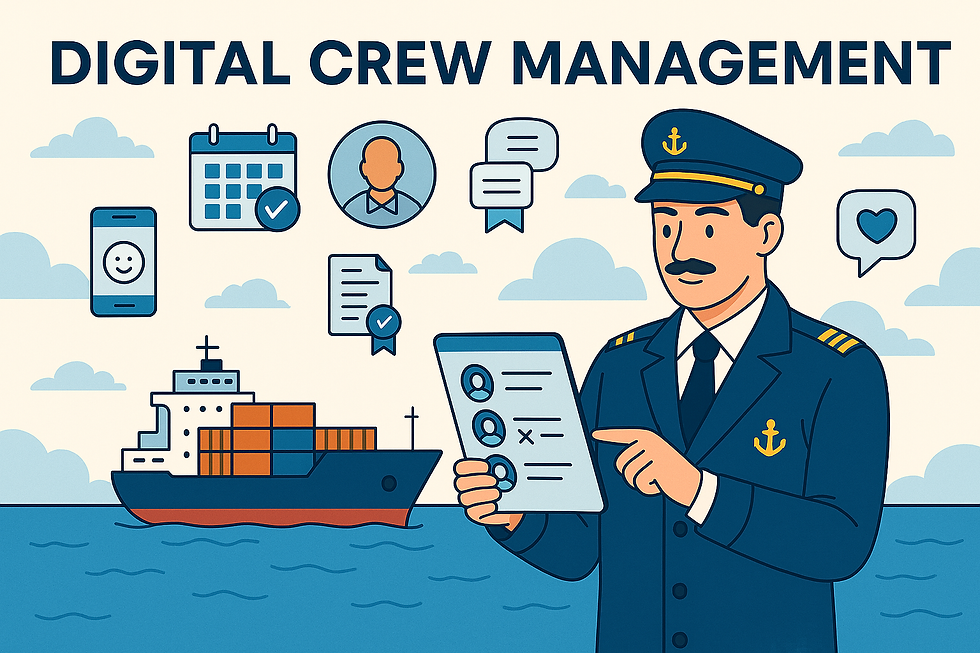🌩️ Cloud vs. Onboard Systems in Shipping: Where Should Your Maritime Data Reside?
- Davide Ramponi

- 27. Okt.
- 4 Min. Lesezeit
My name is Davide Ramponi, I’m 21 years old and currently training as a shipping agent in Hamburg.On my blog, I take you with me on my journey into the exciting world of shipping. I share my knowledge, my experiences, and my progress on the way to becoming an expert in the field of Sale and Purchase – the trade with ships.

In today’s post, we’re diving into a topic that’s transforming the way fleets operate around the globe: Where should maritime data be processed and stored — in the cloud or onboard? 🌐⚓
Whether we’re talking about condition monitoring, emissions tracking, or voyage optimization — data is now the fuel of the shipping industry. But where that data lives affects everything from latency to cybersecurity, operational resilience, and long-term flexibility.
🔍 In this post, I’ll walk you through:
⚖️ The pros and cons of cloud vs. onboard data architecture
🔐 Key trade-offs: cybersecurity, latency, and operational control
🔁 Hybrid models that blend both approaches
🛳️ Real-world examples from major shipping operators
🔮 What the future holds for maritime data systems
Let’s set sail! ⛵
⚙️ Cloud vs. Onboard: What's the Difference?
Before we jump into strategies and use cases, let’s define the two primary approaches.
☁️ Cloud-Based Systems (Centralized)
Cloud systems rely on remote, land-based data centers to store and analyze ship data. Vessels send information via satellite or 5G to the cloud, where it is processed and integrated with central business systems.
⚓ Onboard Systems (Localized)
Onboard systems handle all critical data storage and processing on the vessel itself. They often run offline, with periodic synchronization when connectivity allows.
🔍 Cloud vs. Onboard – Side-by-Side Comparison
Let’s look at the five key dimensions that matter when choosing a maritime IT architecture.
1️⃣ ⏱️ Latency & Real-Time Operations
Cloud:
✅ Great for analytics and long-term insights
❌ Delayed feedback in real-time operations due to network lag
Onboard:
✅ Instant access and control — ideal for engine tuning, navigation, alarm
❌ Limited computational power for complex forecasting
2️⃣ 🕹️ Operational Control
Cloud:
✅ Centralized management and easier standardization
❌ Reduces local crew autonomy
Onboard:
✅ Full control remains with the crew — even offline
❌ May lead to inconsistencies across fleet if not monitored centrally
3️⃣ 📡 Scalability & Integration
Cloud:
✅ Easily scaled across fleets and connected with third-party tools (charterers, ports, etc.)
❌ Depends heavily on stable internet connectivity
Onboard:
✅ Fully customized to ship needs
❌ Rolling out changes fleet-wide is more time-consuming
4️⃣ 🔐 Cybersecurity
Cloud:
✅ Enterprise-grade protection (AWS, Azure, etc.)
❌ Broader attack surface from external connections
Onboard:
✅ Physically isolated systems reduce remote hacking risk
❌ Manual updates and patches leave room for human error
5️⃣ 🔄 System Resilience
Cloud:
❌ Risk of downtime if connectivity is lost
Onboard:
✅ Autonomous, uninterrupted operations — even during full disconnection
🧠 Bottom line: Each system has strengths and weaknesses. Choosing the right one depends on mission-critical needs, connectivity conditions, and IT maturity.
🔁 Hybrid Systems: The Best of Both Worlds?
A growing number of fleet operators are taking a hybrid approach — using both onboard and cloud systems in tandem.
🔧 What is a Hybrid Maritime IT Model?
In a hybrid setup, tasks are distributed:
Mission-critical systems (navigation, propulsion, safety) are handled onboard
Non-urgent analytics (fuel efficiency, emissions logs) are uploaded to the cloud
✅ Advantages of Hybrid Systems
🛡️ Resilience: Ships remain operational even when offline
⚙️ Efficiency: Less burden on local systems, smarter decisions onshore
🔄 Flexibility: Seamless data sync when connections are available
🔍 Real-world example:Eastern Pacific Shipping runs digital twins locally for onboard optimization, while using the cloud for cross-fleet emissions benchmarking — combining speed with strategy.
🛳️ Operator Insights: What’s Happening in the Field?
📦 Maersk – Cloud-First, Edge-Aware
Uses cloud for fleet-wide optimization, emissions, and routing
Keeps edge systems onboard for real-time control of engines and trim🧠 Balance of scale and local action
🛰️ NYK Line – Hybrid Model
Measures hull stress and fatigue with onboard sensors
Uploads data to the cloud post-voyage for long-term maintenance planning⚓ Safety onboard, strategy ashore
🛳️ Carnival Cruise Line – Bandwidth-Smart Systems
Prioritizes navigation and safety systems onboard
Sends HVAC and energy data to the cloud while in port📶 Maximizing bandwidth and minimizing risk
🔮 Future Trends in Maritime IT Architecture
1️⃣ 🛰️ Satellite Network Expansion
Low-Earth Orbit constellations (Starlink, OneWeb) are changing the game.
Lower latency, higher bandwidth at sea
More realistic full-time cloud connectivity for mid-ocean operations
2️⃣ 🧠 Edge-Based AI
Smart ships will increasingly run AI models locally:
Detect system failures early
Optimize fuel usage based on sea conditions
Make autonomous adjustments — even offline
3️⃣ 📜 Real-Time Compliance
With rules like EU ETS, CII, and IMO DCS, continuous reporting is becoming mandatory.
Systems need to track and transmit performance data automatically
Hybrid setups will be key to maintaining compliance and flexibility
4️⃣ 🧩 Modular System Design
Future ships will use plug-and-play systems:
Easier retrofits
Longer system life
Customization based on trade route, cargo type, or charter party
🧭 Conclusion: Where Should Your Data Live?
There’s no universal answer — just strategic choices.
Onboard systems = speed, autonomy, resilienceCloud systems = scalability, integration, insight Hybrid systems = the sweet spot of both
Key Takeaways 🎯
⚓ Choose onboard systems for real-time operations and critical safety
☁️ Use the cloud for analytics, reporting, and strategic oversight
🔁 Embrace hybrid models to future-proof your fleet
🧠 Stay agile — tech will continue evolving
As digitalization transforms maritime operations, your data architecture is no longer a technical detail — it’s a competitive advantage.
💬 Share your thoughts in the comments — I look forward to the exchange!





Kommentare